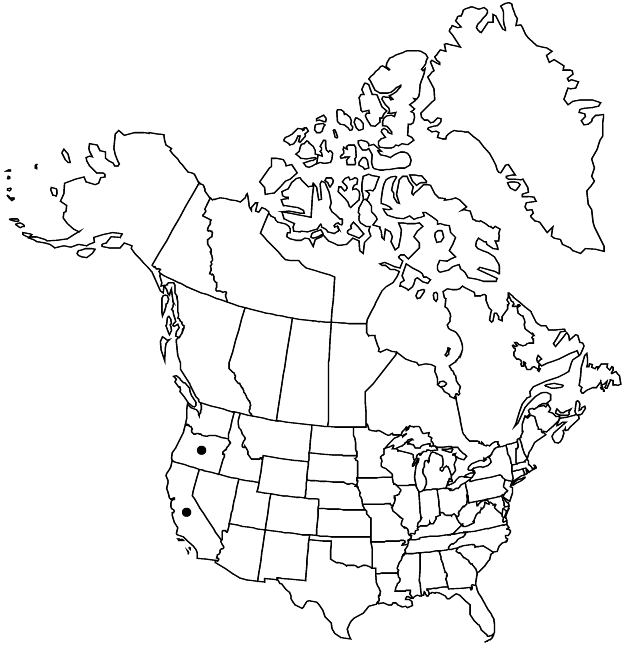Difference between revisions of "Sedum laxum"
in H. G. A. Engler et al., Nat. Pflanzenfam. ed. 2, 18a: 451. 1930,.
FNA>Volume Importer |
FNA>Volume Importer |
||
| Line 18: | Line 18: | ||
}}<!-- | }}<!-- | ||
| − | --><span class="statement" id="st-undefined" data-properties=""><b>Herbs,</b> perennial, cespitose or not, glabrous. <b>Stems</b> root-stocks, ascending, much-branched, bearing rosettes. <b>Leaves</b> alternate, erect to spreading, sessile; blade green, glaucous or not, not pruinose, oblanceolate, spatulate, or obovate, subterete or somewhat flattened, 10–50 × (4.5–)6–33 mm, base not spurred, not scarious, apex truncate to rounded or obtuse, emarginate or barely notched. <b>Flowering</b> shoots erect or decumbent, simple or branched, 4–30(–40) cm; leaf blades oblanceolate, spatulate, obovate, or suborbiculate, base not spurred; offsets not formed. <b>Inflorescences</b> elongate, paniculate cymes, 12–80-flowered, monochasially 3+-branched; branches not recurved, 2-forked; bracts similar to leaves, smaller. <b>Pedicels</b> 0.6–6.3 mm. <b>Flowers</b> 5-merous; sepals erect, (closely appressed to corolla tube), slightly connate basally, pale green, ovate or lanceolate, equal, (2–)2.6–5.1 × 2 mm, apex acute or subacute, (rarely obtuse in var. flavidum); petals basally erect, divergent in distal 1/2, connate basally, pink, pinkish white, or white to yellowish white, lanceolate-oblong, oblanceolate-oblong, or elliptic-oblong, not carinate, 4–11 mm, apex obtuse, shortly mucronate or aristate; filaments white, greenish white, or pink; anthers red, reddish purple, red-brown, or yellow; nectar scales white, yellow, or pink, reniform or transversely oblong. <b>Carpels</b> erect in fruit, distinct, brown.</span><!-- | + | --><span class="statement" id="st-undefined" data-properties=""><b>Herbs,</b> perennial, cespitose or not, glabrous. <b>Stems</b> root-stocks, ascending, much-branched, bearing rosettes. <b>Leaves</b> alternate, erect to spreading, sessile; blade green, glaucous or not, not pruinose, oblanceolate, spatulate, or obovate, subterete or somewhat flattened, 10–50 × (4.5–)6–33 mm, base not spurred, not scarious, apex truncate to rounded or obtuse, emarginate or barely notched. <b>Flowering</b> shoots erect or decumbent, simple or branched, 4–30(–40) cm; leaf blades oblanceolate, spatulate, obovate, or suborbiculate, base not spurred; offsets not formed. <b>Inflorescences</b> elongate, paniculate cymes, 12–80-flowered, monochasially 3+-branched; branches not recurved, 2-forked; bracts similar to leaves, smaller. <b>Pedicels</b> 0.6–6.3 mm. <b>Flowers</b> 5-merous; sepals erect, (closely appressed to corolla tube), slightly connate basally, pale green, ovate or lanceolate, equal, (2–)2.6–5.1 × 2 mm, apex acute or subacute, (rarely obtuse in <i></i>var.<i> flavidum</i>); petals basally erect, divergent in distal 1/2, connate basally, pink, pinkish white, or white to yellowish white, lanceolate-oblong, oblanceolate-oblong, or elliptic-oblong, not carinate, 4–11 mm, apex obtuse, shortly mucronate or aristate; filaments white, greenish white, or pink; anthers red, reddish purple, red-brown, or yellow; nectar scales white, yellow, or pink, reniform or transversely oblong. <b>Carpels</b> erect in fruit, distinct, brown.</span><!-- |
-->{{Treatment/Body | -->{{Treatment/Body | ||
|distribution=w United States. | |distribution=w United States. | ||
|discussion=<p>Varieties 5 (5 in the flora).</p><!-- | |discussion=<p>Varieties 5 (5 in the flora).</p><!-- | ||
| − | --><p>Sedum laxum is unusual in forming offsets in axils of rosette leaves rather than on a rootstock or creeping stem.</p> | + | --><p><i>Sedum laxum</i> is unusual in forming offsets in axils of rosette leaves rather than on a rootstock or creeping stem.</p> |
|tables= | |tables= | ||
|references= | |references= | ||
| Line 82: | Line 82: | ||
|publication year= | |publication year= | ||
|special status= | |special status= | ||
| − | |source xml=https://jpend@bitbucket.org/aafc-mbb/fna-data-curation.git/src/ | + | |source xml=https://jpend@bitbucket.org/aafc-mbb/fna-data-curation.git/src/8f726806613d60c220dc4493de13607dd3150896/coarse_grained_fna_xml/V8/V8_449.xml |
|genus=Sedum | |genus=Sedum | ||
|species=Sedum laxum | |species=Sedum laxum | ||
Revision as of 19:06, 18 September 2019
Herbs, perennial, cespitose or not, glabrous. Stems root-stocks, ascending, much-branched, bearing rosettes. Leaves alternate, erect to spreading, sessile; blade green, glaucous or not, not pruinose, oblanceolate, spatulate, or obovate, subterete or somewhat flattened, 10–50 × (4.5–)6–33 mm, base not spurred, not scarious, apex truncate to rounded or obtuse, emarginate or barely notched. Flowering shoots erect or decumbent, simple or branched, 4–30(–40) cm; leaf blades oblanceolate, spatulate, obovate, or suborbiculate, base not spurred; offsets not formed. Inflorescences elongate, paniculate cymes, 12–80-flowered, monochasially 3+-branched; branches not recurved, 2-forked; bracts similar to leaves, smaller. Pedicels 0.6–6.3 mm. Flowers 5-merous; sepals erect, (closely appressed to corolla tube), slightly connate basally, pale green, ovate or lanceolate, equal, (2–)2.6–5.1 × 2 mm, apex acute or subacute, (rarely obtuse in var. flavidum); petals basally erect, divergent in distal 1/2, connate basally, pink, pinkish white, or white to yellowish white, lanceolate-oblong, oblanceolate-oblong, or elliptic-oblong, not carinate, 4–11 mm, apex obtuse, shortly mucronate or aristate; filaments white, greenish white, or pink; anthers red, reddish purple, red-brown, or yellow; nectar scales white, yellow, or pink, reniform or transversely oblong. Carpels erect in fruit, distinct, brown.
Distribution

w United States.
Discussion
Varieties 5 (5 in the flora).
Sedum laxum is unusual in forming offsets in axils of rosette leaves rather than on a rootstock or creeping stem.
Selected References
None.
Lower Taxa
Key
| 1 | Flowering shoot leaf bases clasping stems. | Sedum laxum var. heckneri |
| 1 | Flowering shoot leaf bases not clasping stems | > 2 |
| 2 | Petals pale yellow or white with pink mid- veins; sepal apices obtuse. | Sedum laxum var. flavidum |
| 2 | Petals pink or white; sepal apices acute | > 3 |
| 3 | Flowering shoot leaf blades suborbiculate. | Sedum laxum var. eastwoodiae |
| 3 | Flowering shoot leaf blades spatulate to oblanceolate | > 4 |
| 4 | Leaf blades 9-17 mm wide | Sedum laxum var. laxum |
| 4 | Leaf blades 17-33 mm wide. | Sedum laxum var. latifolium |